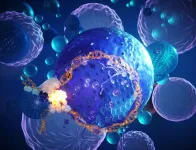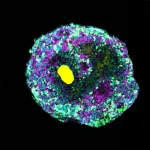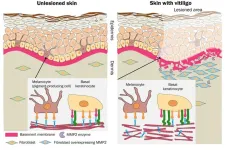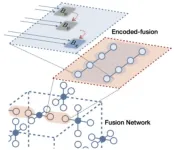(Press-News.org) For more information, contact:
Nicole Fawcett, nfawcett@umich.edu
EMBARGOED for release at 5 a.m. ET Sept. 9, 2024
Researchers identify factor that drives prostate cancer-causing genes
Factor previously known to play a role in advanced cancer is fundamental in early stages of cancer development
ANN ARBOR, Michigan — Researchers at the University of Michigan Health Rogel Cancer Center have uncovered a key reason why a typically normal protein goes awry and fuels cancer.
They found the protein NSD2 alters the function of the androgen receptor, an important regulator of normal prostate development. When androgen receptor binds with NSD2, it causes rapid cell division and growth leading to prostate cancer. The study, published in Nature Genetics, may suggest a new way to therapeutically target prostate cancer.
The findings illuminate a phenomenon not previously understood. The androgen receptor’s normal function is to define the development of the prostate. It tells the cells to stop growing and maintain a normal prostate. But in cancer, androgen receptor does the opposite: it tells the cells to continue growing and drive cancer development.
“Our study is one of the first molecular explanations for this functional duality of the androgen receptor,” said study first author Abhijit Parolia, Ph.D., Rogel fellow and assistant professor of pathology at Michigan Medicine. “NSD2 is a cancer specific collaborator of the androgen receptor that essentially rewires its activity to support prostate cancer development.”
Researchers started with a CRISPR screening to look for cofactors involved in the androgen receptor and prostate cancer. They scoured the enhanceosome, a complex of multiple proteins, including transcription factors and other epigenetic factors, that assemble on the DNA at specific sites to drive the expression of genes. This was contrasted with what’s called the neo-enhanceosome. It’s an analogous machinery, but cancer-causing transcription factors find their way in, reorganize the careful assembly and drive expression of cancer-causing programs.
The androgen receptor typically sits along a specific line of sites within DNA. When NSD2 is present, it rearranges where the androgen receptor “enhanceosome” sits on the DNA, setting it next to sites occupied by known cancer-causing genes and drivers.
“This is the machinery around the genes we know are involved in prostate cancer development, including androgen receptor, ERG and FOXA1. They all use this machinery to regulate oncogenic expression. We’re now working to indirectly target the genes of interest by affecting these epigenetic components like NSD2,” said study co-senior author Arul M. Chinnaiyan, M.D., Ph.D., director of the Michigan Center for Translational Pathology and S.P. Hicks Professor of Pathology at Michigan Medicine.
Researchers found that NSD2 is expressed in prostate cancer cells, but not in normal prostate cells. NSD2 was previously known to be involved in metastatic prostate cancer. This is the first study to show that it is fundamental to the earliest stage of prostate cancer development.
The team used multiple methods to knockdown or halt NSD2 expression in prostate cancer cells and found that doing so returns the cells to a more normal state, slowing the growth and spread of the cancerous cells but not eliminating the cancer. A related protein called NSD1 works along with NSD2, they found.
A compound that degrades both NSD1 and NSD2 successfully destroyed prostate cancer cell lines. The degrader targeted the cancer cells specifically without affecting normal cells. More work is needed to refine the degrader as the initial version could not be translated to a mouse model.
“By degrading NSD1 and NSD2, we can more directly target cancer and avoid the normal tissue,” Chinnaiyan said. “Our study suggests if we’re able to develop NSD1/2-targeting agents, they could potentially be combined with FDA-approved androgen receptor antagonists and have a synergist effect in terms of treatment.”
Additional authors: Sanjana Eyunni, Brijesh Kumar Verma, Eleanor Young, Yihan Liu, Lianchao Liu, James George, Shweta Aras, Chandan Kanta Das, Rahul Mannan, Reyaz ur Rasool, Erick Mitchell-Velasquez, Somnath Mahapatra, Jie Luo, Sandra E. Carson, Lanbo Xiao, Prathibha R. Gajjala, Sharan Venkatesh, Mustapha Jaber, Xiaoju Wang, Tongchen He, Yuanyuan Qiao, Matthew Pang, Yuping Zhang, Jean Ching-Yi Tien, Micheala Louw, Mohammed Alhusayan, Xuhong Cao, Omid Tavana, Caiyun Hou, Zhen Wang, Ke Ding, Irfan A. Asangani
Funding for this work is from Prostate Cancer Foundation; National Cancer Institute grants P50-CA186786, R35 CA231996, P30 CA046592, R00 CA187664, K00 CA245825, R01 CA249210-0; Department of Defense grants W81XWH-21-1-0500, W81XWH-17-0404; Howard Hughes Medical Institute, American Cancer Society. This work was supported by the Rogel Cancer Center Flow Cytometry Shared Resource.
Disclosure: None
Paper cited: “NSD2 is a requisite subunit of the AR/FOXA1 neo-enhanceosome in promoting prostate tumorigenesis,” Nature Genetics. DOI: 10.1038/s41588-024-01893-6
Resources:
University of Michigan Rogel Cancer Center, www.rogelcancercenter.org
Michigan Medicine Cancer AnswerLine, 800-865-1125
# # #
END
A new molecular engineering technique can precisely influence the development of organoids. Microbeads made of specifically folded DNA are used to release growth factors or other signal molecules inside the tissue structures. This gives rise to considerably more complex organoids that imitate the respective tissues much better and have a more realistic cell mix than before. An interdisciplinary research team from the Cluster of Excellence “3D Matter Made to Order” with researchers based at the Centre for Organismal Studies and the Center ...
In hospital operating rooms and intensive care units, propofol is a drug of choice, widely used to sedate patients for their comfort or render them fully unconscious for invasive procedures.
Propofol works quickly and is tolerated well by most patients when administered by an anesthesiologist. But what is happening inside the brain when patients are put under and what does this reveal about consciousness itself?
Investigators at U-M who are studying the nature of consciousness have successfully used the drug to identify the intricate brain geometry behind the unconscious state, offering an unprecedented ...
New research suggests that a family member’s cancer diagnosis may increase first-degree relatives’ and spouses’ risks of developing psychological and cardiovascular illnesses. The findings are published by Wiley online in CANCER, a peer-reviewed journal of the American Cancer Society.
Having a family member diagnosed with cancer can be a stressful and traumatic experience for the entire family. Because stress influences not only mental health but also cardiovascular health, investigators explored whether a cancer diagnosis contributes ...
Skin pigmentation disorders affect people across the world. One of them, vitiligo, is said to have a worldwide incidence of 1-2%. What causes the loss of pigmentation in vitiligo has long been unclear, but an Osaka Metropolitan University-led team has uncovered clues to the mechanism behind the disorder.
In findings published in The Journal of Pathology, Graduate School of Medicine Specially Appointed Associate Professor Lingli Yang, the corresponding author, and researchers including Specially Appointed Professor Ichiro ...
Solving the problem of error is essential for the practical application of quantum computing technologies that surpass the performance of digital computers. Information input into a qubit, the smallest unit of quantum computation, is quickly lost and error-prone. No matter how much we mitigate errors and improve the accuracy of qubit control, as the system size and computation scale increase, errors accumulate and algorithms become impossible to perform. Quantum error correction is a way to solve this problem. As the race for global supremacy in quantum technology intensifies, most major companies and research groups leading the development of quantum ...
Humans will build Artificial Intelligence (AI) which surpasses our own capabilities once we crack the ‘neural code’, says an AI technology analyst.
Eitan Michael Azoff, a specialist in AI analysis, argues that humans are set to engineer superior intelligence with greater capacity and speed than our own brains.
What will unlock this leap in capability is understanding the ‘neural code’, he explains. That’s how the human brain encodes sensory information, and how it ...
Targeting vaccination programs for respiratory syncytial virus (RSV) to older adults with underlying health conditions is a cost-effective way to reduce disease, according to a new modelling study https://www.cmaj.ca/lookup/doi/10.1503/cmaj.240452 in CMAJ (Canadian Medical Association Journal).
RSV infections cause major illness, especially in infants and older adults, and rates of infection increase with age. There are now vaccines available to prevent disease caused by RSV in adults, and vaccination campaigns may reduce the incidence in older adults and associated ...
About The Study: The findings of this cohort study showed a significant recent downward trend in both melanoma incidence and melanoma mortality in the age group 30 to 49 years in Sweden. The reasons for these declines are unclear but may include UV protection, public health campaigns, changing population demographics, and the introduction of effective melanoma treatment. None of these possibilities were evaluated; further study is needed.
Corresponding Author: To contact the corresponding author, Hildur Helgadottir, MD, PhD, email hildur.helgadottir@sll.se.
To access the embargoed study: Visit our For The Media ...
The risk of skin cancer, malignant melanoma, now appears to be decreasing in Sweden - at least in those under 50, according to a new study.
“We can see a trend break in young adults around 2015 where the incidence curves are falling,” says first author Hildur Helgadottir, senior consultant and associate professor of oncology at the Department of Oncology-Pathology, Karolinska Institutet.
She and her research colleagues have analyzed data from the Swedish Melanoma Registry and followed melanoma incidence and mortality for different age segments over time. This means that they have compared individuals in a certain age range at one ...
The chatbot ChatGPT performed better than trainee doctors in assessing complex cases of respiratory disease in areas such as cystic fibrosis, asthma and chest infections in a study presented at the European Respiratory Society (ERS) Congress in Vienna, Austria [1].
The study also showed that Google’s chatbot Bard performed better than trainees in some aspects and Microsoft’s Bing chatbot performed as well as trainees.
The research suggests that these large language models (LLMs) could be used to support trainee doctors, nurses and general practitioners to triage patients more quickly and ease pressure on health services.
The ...




